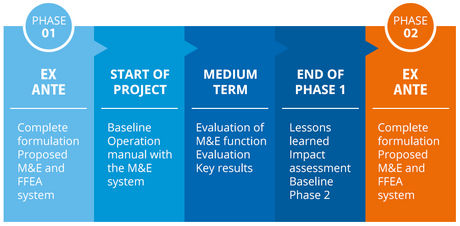The construction of effective tools for Monitoring and Evaluation (M&E) is essential for designing, planning, assessing changes and measuring the results and impacts of a project. This tool offers a critical review of the various instruments used in M&E and reviews the experience of LAPs in Central America. The following instruments are proposed for the various programme phases.
Definition of Monitoring and Evaluation
Monitoring is the ongoing collection of data on specific indicators for assessing the implementation of an intervention (project, programme, policies, etc.) in relation to physical and financial advances (performance) and to the overarching objectives1. Evaluation is the process of assessing the conditions and/or causes of a situation or action, for the purpose of providing useful information for decision-making.2.
The periodic assessment of the design, implementation, results and impacts of an intervention [are] aimed at development. It should evaluate the relevance and scope of objectives, implementation in terms of effectiveness and efficiency and the nature, distribution and sustainability of impacts.3.
The concept of evaluation has three key components; i) That it can be carried out at any time during the programme; ii) That it seeks to understand the causal links between the actions of a project and its results; and iii) That it should be geared to provide useful information for decision-making to maximize achievements.
As with investment projects, the M&E system of LAPs should be considered in relation to the various stages in the project cycle.
Each module contains instruments for the ex-ante phase of the project, for the start, medium term, final evaluation and ex-post evaluation of each phase. As LAPs are generally investment programmes with three phases of 5 to 6 years each (see module 1), impacts or key results can be evaluated in the medium term or at the end of each of these phases, and this evaluation represents in turn a very valuable source of information for making the necessary adjustments in subsequent stages. Impact assessments can even be carried out during the next project phase since the effects of institutional reforms and efforts to strengthen security and legal certainty about tenure require time to become established.

- Diagram 1: Development of the M&E system in the project cycle
As shown in the project cycle, the main stages to be considered for the development of M&E systems are:
Stages in the development of the M&E system of LAPs
Stage | | Development of the M&E System |
|---|
Ex Ante | The project and its strategies are formulated before there is a defined institutional and organizational structure. | - The Results Framework is defined, and then how the project should be evaluated.
- The Fiscal, Financial and Economic Analysis (FFEA) is carried out to ensure that the project will generate sufficient economic, financial and fiscal benefits for the country.
|
Start of the project | The Global Operating Plan (GOP) and the Project Operation Manual (POM) should be developed and the implementation of components started. | - The project baseline is defined for the indicators which measure the key effects of the project, at its various levels of intervention.
- GOP and AOP are developed so that activities are aligned with the products and results of the components.
- The POM should include a chapter on the M&E system according to the results framework and the approach to impact assessment.
- The agreements and systems for collecting information from the various co-executing institutions should be established.
|
Implementation | The project is implemented according to the AOP and POM | - Results indicators of component compliance are monitored.
- The AOPs are followed up to monitor how physical and financial goals are being met..
- Participatory evaluation exercises are carried out to determine user and beneficiary perception of the mode of operation of the project.
|
Medium term | This is a key stage in the project cycle when reorientation can be carried out if necessary. | - The main results and effects indicators are generally evaluated by external consultancy services.
- The consistency of the M&E system is evaluated
- If necessary, the Results Framework is reformulated.
|
End of the project | Before the end of the project implementation, administrative closure is prepared and information generated for any subsequent phase. | - All the information generated by the M&E system is collected.
- The main results and effects indicators are evaluated by external consultancy services and the baseline for the next phase is defined if necessary.
- The results are compared with baseline to show the effects of the project.
- The FFEA is carried out to assess how the feasibility goals of the project have been met.
- The lessons learned are established with various key players in the project to facilitate the formulation of the next stage.
|
1 OECD (2002).
2 Ferrández, A. (1993); De la Orden Hoz, A. (1990); Cronbach, L. (1963); Stuffllebeam, D. (1987).
3 OECD (2002).




